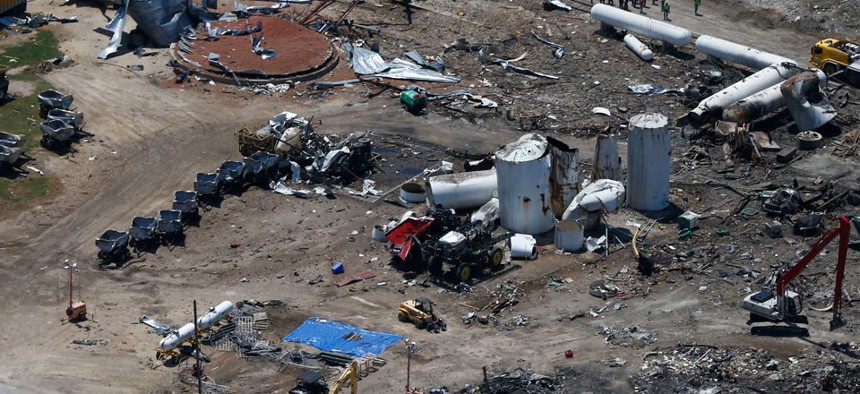
The fertilizer plant explosion in West, Texas occurred in April. Charles Dharapak/AP
Obama Chemical Safety Order Could Help Keep Peace Among Feuding Agencies
ATF, Chemical Board and others asked to better share accident information.
President Obama’s Aug. 1 executive order on chemical safety has raised hopes for improved cooperation among agencies that are sometimes at loggerheads over whose regulations and agendas take precedence in preventing and investigating serious accidents, according to interviews with Government Executive.
In response to the April 17 fertilizer plant fire in West, Texas, that killed 15, Obama signed an order “to improve security of chemical facilities and reduce the risks of hazardous chemicals to workers and communities.” It sets deadlines for a half-dozen agencies to improve operational coordination with state and local partners; enhance federal agency coordination and information sharing; modernize policies, regulations and standards; and work with stakeholders to identify best practices.
The Environmental Protection Agency, the Occupational Safety and Health Administration and the Homeland Security Department were criticized in the aftermath of the tragedy for having out-of-date chemical regulations and being unaware of the risks before the explosion. And during the subsequent criminal investigation, the Bureau of Alcohol, Tobacco and Firearms clashed with the nonregulatory independent U.S. Chemical Safety Board over control of the accident site’s data for determining the accident’s causes.
The Obama order was embraced as a “game-changer” by Sen. Barbara Boxer, D-Calif., chairwoman of the Senate Environment and Public Works Committee. “Knowing the president's deep commitment to the people of West, Texas, after the tragic explosion of ammonium nitrate, I informed him last week of specific ideas that emanated from a hearing I chaired at the Environment and Public Works Committee,” she said in a statement. “I couldn't be more gratified to learn today that he is taking executive action to follow through….The EPA has not updated its alert since 1997, and the best practices recommended by other federal agencies such as OSHA are not being uniformly followed.”
At Boxer’s June 27 hearing on the accident, EPA and OSHA were said to be crimped by resources “under duress,” in the testimony of Rafael Moure-Eraso, chairman of the Chemical Safety Board, whose mission is to review regulations of other agencies and recommend improvements.
He too welcomed Obama’s order, noting that it “calls for the revision and strengthening of EPA’s Risk Management Program and OSHA’s Process Safety Management standard. The CSB has long urged such improvements, specifically that reactive hazards -- such as ammonium nitrate -- be more comprehensively regulated.”
In an interview Wednesday, Moure-Eraso said, “We need to rationalize the way in which parallel investigations take place so that in the end we will create information that will improve guidelines and regulations to prevent incidents from happening.” The order can help clarify “how we can work together with agencies when it comes to access to information and witnesses on the site,” he said. ATF and the CSB, he added, “have different goals and different needs when we show up at the site,” the ATF focusing on identifying criminality and the chemical board on why “this catastrophe occurred.”
Daniel Horowitz, the CSB’s managing director, said “at an accident site all these goals are compatible. All the agencies share an interest in evidence and preservation and access to witnesses, and in understanding and interpreting the site and the data it holds. So there ought to be a way to work it out through” the existing memorandum of understanding between the agencies.
The chemical board has been in discussions with ATF on clarifying their respective roles during investigations, Moure-Eraso said, but progress had been delayed by the uncertain status of B. Todd Jones, who was confirmed as ATF director the day before Obama’s order.
Obama’s order “contemplates a new overarching” memorandum of understanding, Horowitz added, which the chemical board has been discussing with the Justice Department, ATF’s parent.
ATF spokesman Mike Campbell said all the agencies involved are participating in a working group, and that “one of the things we are looking back at is our memorandum of understanding with CSB,” with an eye toward updating it to be “more in line with what everybody needs.” ATF has been holding conference calls with explosives industry associations, and has been expanding federal intra-agency training and education at its National Center for Explosives Training and Research in Huntsville, Ala., Campbell added.
Homeland Security, meanwhile, has been working to improve and expand its Chemical Facility Anti-Terrorism Standards program, David Wulf, a director in the department’s National Protection and Programs Directorate, told a House Homeland Security subcommittee on Aug. 1. “These coordinated efforts will help ensure that the federal government most effectively uses the collective resources available to us for managing chemical risk," he said. "These activities complement many of the individual efforts being taken within the department, and other federal departments and agencies, following the tragic events in West, Texas.”
EPA and OSHA declined comment.







